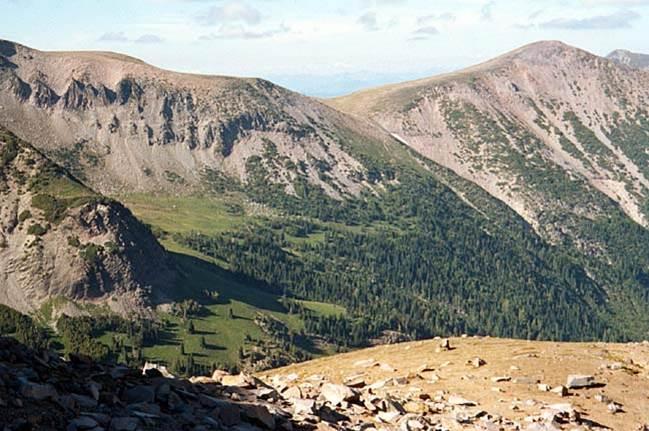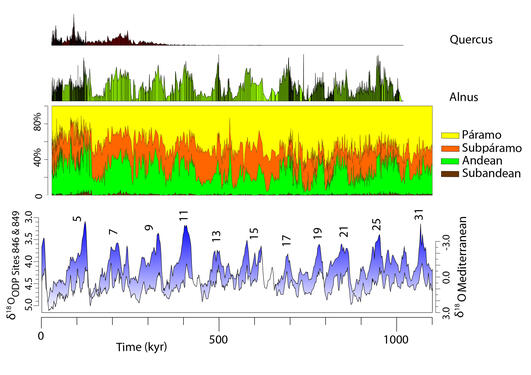IGNEX
Interglacials and glacials - natural experiments in biodiversity dynamics

Main content
IGNEX and its sister project IGNEX-eco will use the same datasets but very different numerical procedures and analytical techniques to address different aspects of long-term dynamics (IGNEX) and of ecosystem assembly and its relevance to restoration ecology (IGNEX-eco).
There are three major ecological hypotheses to explain plant community structure
- extrinsic external environmental control where communities are structured primarily through plant responses to the environment, especially climate
- intrinsic internal species interactions e.g. facilitation, mutualism, herbivory, and above all, competition
- neutral dynamics, random processes and historical legacies
These hypotheses are not mutually exclusive and attempts are being made to unite them. Disentangling and assessing the relative roles of environment, interactions, and neutrality in plant community assembly, composition, and structure requires a historical dimension because, as Jeannine Cavender-Bares notes (in Stokstad 2009: Science) "you cannot understand the assembly process if you do not think about time" and as Steve Jackson and Jessica Blois (2015: PNAS) emphasise "a consensus is emerging that community properties cannot be understood without biogeographical and historical contexts". Long-tem palaeoecological data from detailed pollen analyses of continuous sequences covering 100,000 - 1,000,000 years provide the historical dimension.
During these time periods, Earth has experienced major climatic shifts from temperate interglacial stages (we live in the latest interglacial) to cool, often dry, glacial 'ice-age' stages. Due to advances in sediment coring and chronology and a huge amount of time-consuming pollen analysis, continuous records of pollen change (and hence, by inference, vegetation change) through alternating interglacial and glacial stages from Greece, NE Russia, and Colombia are now available. Each of these records, plus sequences for three different interglacial stages in Denmark, provides a long-term ecological observatory. The changes from glacial to interglacial conditions are a series of 'natural experiments' on vegetation change and they can be used to test ecological hypotheses about the determinants of long-term community assembly, composition, and structure and of biodiversity dynamics (taxonomic, functional, phylogenetic) and turnover.
The IGNEX projects will use numerical methods to detect major recurring patterns of vegetation change, biodiversity, and turnover for each interglacial stage, for each glacial-interglacial pair, for all glacial stages, and for all interglacial stages. Six main hypotheses will be evaluated.
- There are consistent patterns in taxonomic, functional, phylogenetic, and attribute diversity and compositional turnover between interglacials in a geographical area and within interglacials of the same marine isotope stage (= age) in different areas - this will be a particular focus of IGNEX-eco.
- There is a complex dynamic of extrinsic environmental change, intrinsic species interactions, and ecological drift within a glacial and subsequent interglacial couplet.
- There are long-term ecological legacies where IG composition and biodiversity are contigent on the preceding glacial conditions.
- Different interglacials have different compositions. If so, are the assemblages, although differing in composition, similar in taxonomic, functional, phylogenetic, and attributional diversity and do they show the same amout of compositional turnover? Are differences in IG composition and/or biodiversity explicable (in a statistical sense) in terms of environmental differences, particularly solar insolation?
- Different interglacials have assemblages and taxon combinations that do not occur today: no-analogue or 'novel' assemblages.
- There are consistent assembly patterns between different IGs, at least at the scale of functional traits or phylogenetic relationshps, if not at the scale of taxonomic identity - this will be a particular focus of IGNEX-eco.
Testing of these hypotheses is important in establishing 'baseline conditions' for restoration ecology, in predicting biotic responses to future environmental change, and in providing a factual basis for future conservation.
IGNEX and its sister project IGNEX-eco, involve 18 research colleagues and support staff
John Birks (PI), University of Bergen
Blas Benito, based at University of Bergen
Henry Hooghiemstra and Vladimir Torres, University of Amsterdam, The Netherlands
Ulrike Herzschuh, AWI Polar and Marine Research, Potsdam, Germany
Thomas Giesecke, Univesity of Göttingen, Germany (now at University of Utrecht, Netherlands)
Anson Mackay and Chronis Tzedakis, University College London, UK
Petr Kunes, Charles University, Prague, Czech Republic
Donatella Magri, University of Rome, Italy
Bjørg Risebrobakken, Uni Research, Bergen
Vivian Felde, Hilary Birks, Alistair Seddon, Joe Chipperfield (now at NMBU), Linn Krüger, Cathy Jenks, University of Bergen
Cajo ter Braak, Wageningen, The Netherlands, will provide statistical advice and develop new procedures, particularly for palaeo-trait analysis.
Jacques-Louis de Beaulieu and Maurice Reille, Centre National de la Recherche Scientifique, Marseille, France
Phil Holden, The Open University, UK
This project and IGNEX-eco are based on agreed data-sharing and collaboration. These two projects are a major international research effort that exploits the unique long continuous pollens equences as long-term natural experiments in biodiveristy dynamics, ecosystem assembly, vegetational dynamics, and applied palaeoecology.
IGNEX is a NFR-funded FRIMEDBIO project (249894) that ran from October 2016 to July 2020.
Papers
Benito, B.M. & Birks, H.J.B. (2020) distantia: an open-source toolset to quantify dissimilarity between multivariate ecological time-series. Ecography 43: 660-667. 10.1111/ecog.04895
Benito, B.M., Gil-Romera, G. & Birks, H.J.B. (2020) Ecological memory at millennial time-scales: the importance of data constraints, species longevity and niche features. Ecography 43: 1-10. 10.1111/ecog.04772

